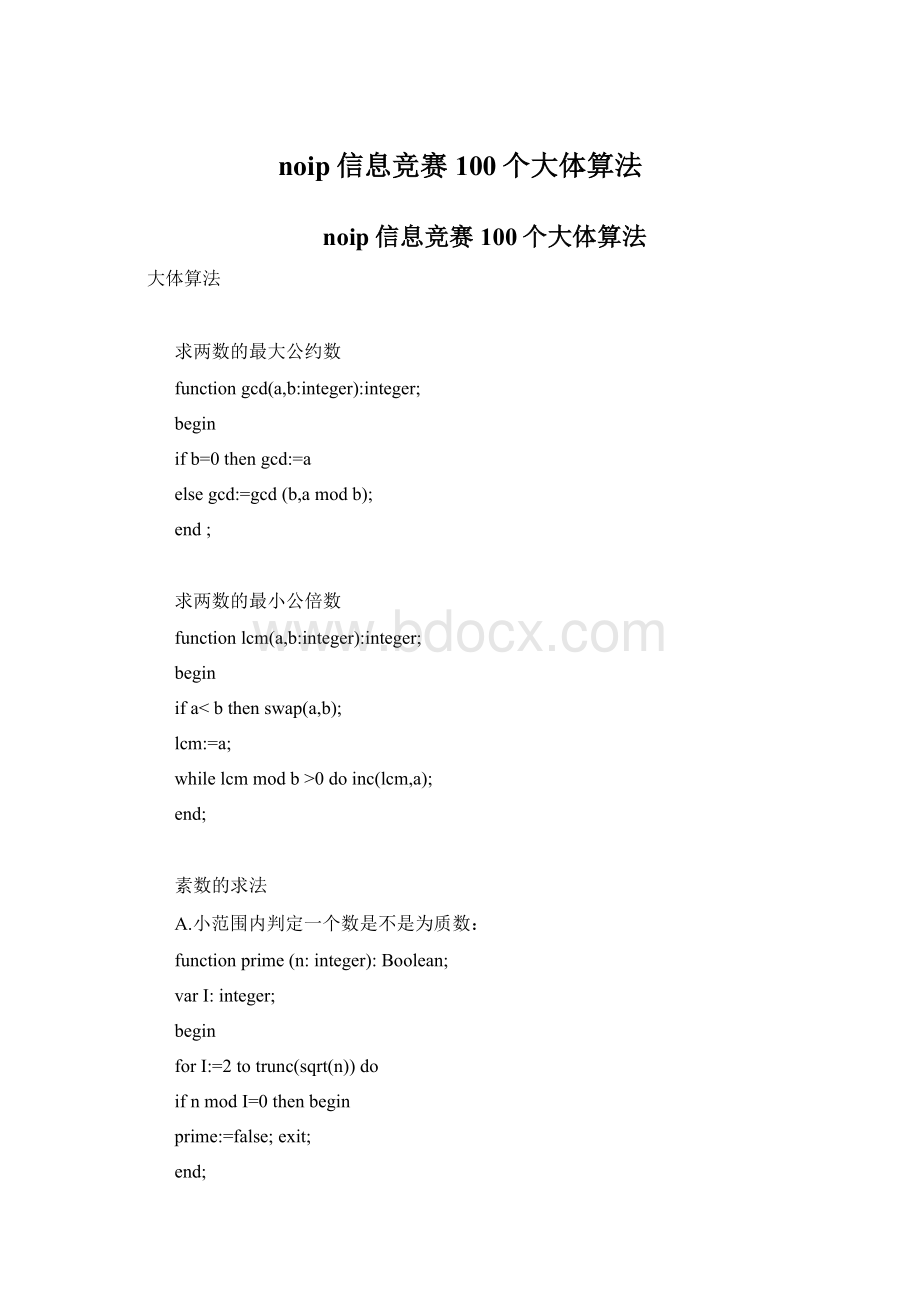noip信息竞赛100个大体算法Word格式文档下载.docx
《noip信息竞赛100个大体算法Word格式文档下载.docx》由会员分享,可在线阅读,更多相关《noip信息竞赛100个大体算法Word格式文档下载.docx(17页珍藏版)》请在冰豆网上搜索。

0doinc(lcm,a);
end;
素数的求法
A.小范围内判定一个数是不是为质数:
functionprime(n:
integer):
Boolean;
varI:
integer;
forI:
=2totrunc(sqrt(n))do
ifnmodI=0thenbegin
prime:
=false;
exit;
=true;
B.判定longint范围内的数是不是为素数(包括求50000之内的素数表):
proceduregetprime;
var
i,j:
longint;
p:
array[1..50000]ofboolean;
fillchar(p,sizeof(p),true);
p[1]:
i:
=2;
whilei<
50000dobegin
ifp[i]thenbegin
j:
=i*2;
whilej<
p[j]:
inc(j,i);
inc(i);
l:
=0;
fori:
=1to50000do
inc(l);
pr[l]:
=i;
{getprime}
functionprime(x:
longint):
vari:
=1toldo
ifpr[i]>
=xthenbreak
elseifxmodpr[i]=0thenexit;
{prime}
2.
3.
算法:
procedureprim(v0:
integer);
var
lowcost,closest:
array[1..maxn]ofinteger;
i,j,k,min:
=1tondobegin
lowcost[i]:
=cost[v0,i];
closest[i]:
=v0;
=1ton-1dobegin
{寻觅离生成树最近的未加入极点k}
min:
=maxlongint;
forj:
=1tondo
if(lowcost[j]<
min)and(lowcost[j]<
>
0)thenbegin
=lowcost[j];
k:
=j;
lowcost[k]:
{将极点k加入生成树}
{生成树中增加一条新的边k到closest[k]}
{修正各点的lowcost和closest值}
ifcost[k,j]<
lwocost[j]thenbegin
lowcost[j]:
=cost[k,j];
closest[j]:
=k;
{prim}
(贪婪)
按权值递增顺序删去图中的边,假设不形成回路那么将此边加入最小生成树。
functionfind(v:
{返回极点v所在的集合}
=1;
while(i<
=n)and(notvinvset[i])doinc(i);
ifi<
=nthenfind:
=ielsefind:
procedurekruskal;
tot,i,j:
=1tondovset[i]:
=[i];
{初始化概念n个集合,第I个集合包括一个元素I}
=n-1;
q:
tot:
{p为尚待加入的边数,q为边集指针}
sort;
{对所有边按权值递增排序,存于e[I]中,e[I].v1与e[I].v2为边I所连接的两个极点的序号,e[I].len为第I条边的长度}
whilep>
0dobegin
=find(e[q].v1);
j:
=find(e[q].v2);
jthenbegin
inc(tot,e[q].len);
vset[i]:
=vset[i]+vset[j];
vset[j]:
=[];
dec(p);
inc(q);
writeln(tot);
A.标号法求解单源点最短途径:
a:
array[1..maxn,1..maxn]ofinteger;
b:
{b[i]指极点i到源点的最短途径}
mark:
array[1..maxn]ofboolean;
procedurebhf;
best,best_j:
fillchar(mark,sizeof(mark),false);
mark[1]:
b[1]:
{1为源点}
repeat
best:
Ifmark[i]then{对每一个已计算出最短途径的点}
if(notmark[j])and(a[i,j]>
0)then
if(best=0)or(b[i]+a[i,j]<
best)thenbegin
=b[i]+a[i,j];
best_j:
ifbest>
0thenbegin
b[best_j]:
=best;
mark[best_j]:
untilbest=0;
{bhf}
算法求解所有极点对之间的最短途径:
procedurefloyed;
ifa[I,j]>
0thenp[I,j]:
=Ielsep[I,j]:
{p[I,j]表示I到j的最短途径上j的前驱结点}
fork:
=1tondo{列举中间结点}
ifa[i,k]+a[j,k]<
a[i,j]thenbegin
a[i,j]:
=a[i,k]+a[k,j];
p[I,j]:
=p[k,j];
C.Dijkstra算法:
类似标号法,本质为贪婪算法。
b,pre:
{pre[i]指最短途径上I的前驱结点}
proceduredijkstra(v0:
d[i]:
=a[v0,i];
ifd[i]<
0thenpre[i]:
=v0elsepre[i]:
mark[v0]:
repeat{每循环一次加入一个离1集合最近的结点并调整其他结点的参数}
=maxint;
u:
{u记录离1集合最近的结点}
if(notmark[i])and(d[i]<
min)thenbegin
=d[i];
ifu<
mark[u]:
if(notmark[i])and(a[u,i]+d[u]<
d[i])thenbegin
=a[u,i]+d[u];
pre[i]:
=u;
untilu=0;